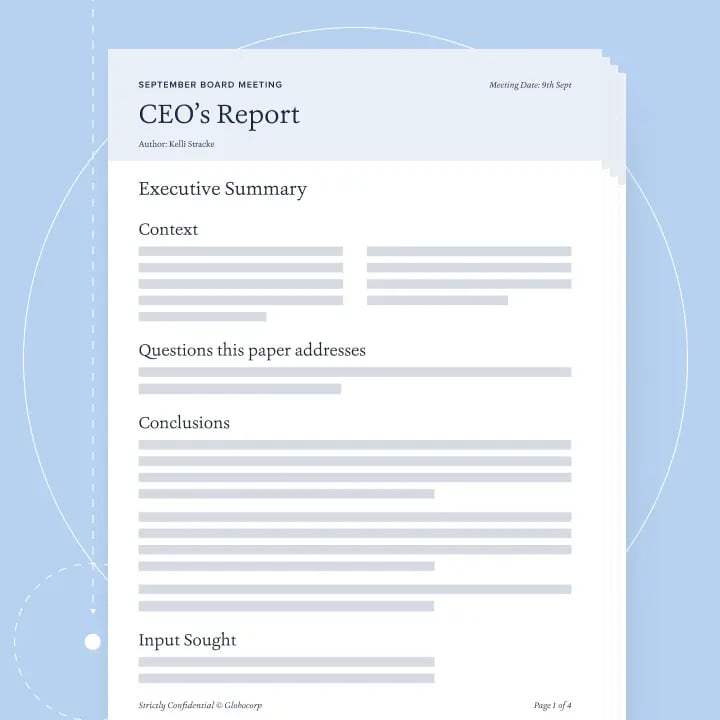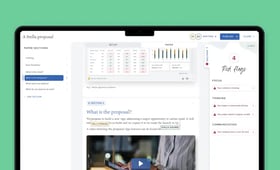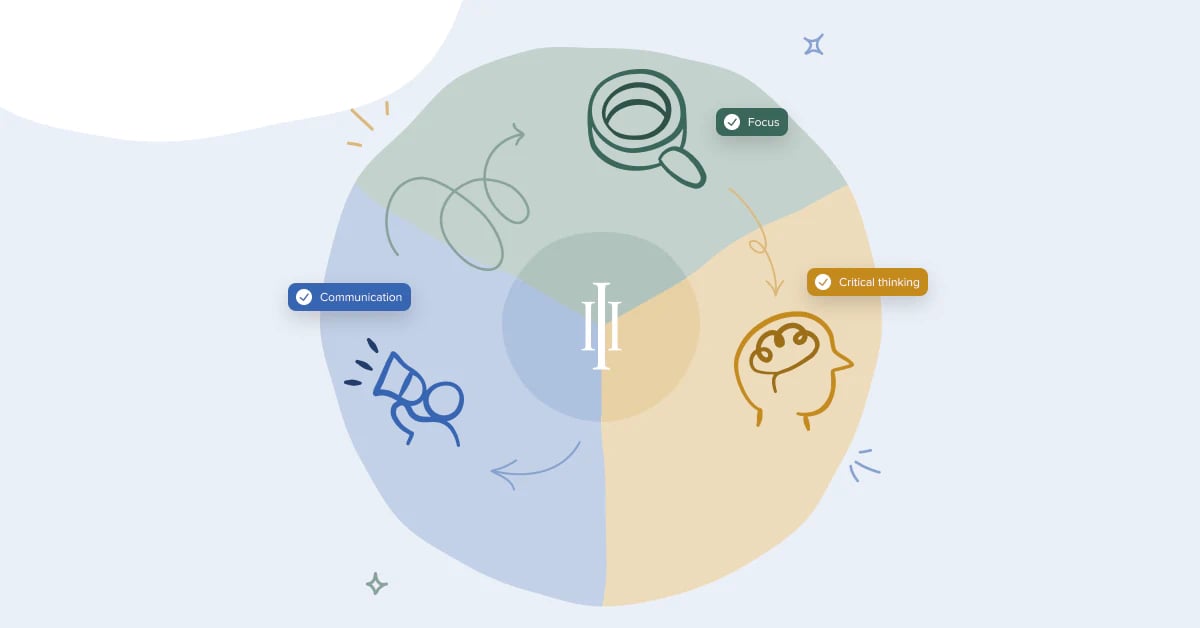Key takeaways
- Collective intelligence helps organizations make better decisions together.
- Teams outperform individuals when given the right conditions.
- Real-world examples show collective intelligence in action.
- Critical thinking, communication, and focus are essential to building team intelligence.
- Leadership and AI tools can enhance collective intelligence without extra workload.
What is collective intelligence and what real-world impact does it have?
Collective intelligence happens when you get teams thinking together, producing insights, and making smarter decisions than they could have done on their own.
Without collective intelligence, we wouldn’t have the iPhone. Nor would Berkshire Hathaway have made its now-famous investment in Apple.
How teams generate smarter decisions together
When diverse minds collaborate, they spot gaps and make smarter calls faster. Structured debates encourage fresh insights and reduce groupthink in meetings. Teams aligned on purpose move quickly because they build on each other’s ideas.
The Apple iPhone story: When collective intelligence overruled Steve Jobs
Early in its development, Steve Jobs actually tried to stop his team from working on the project because he didn’t want Apple to operate in the cell phone market. “We’re not good at that”, he said in 2005. It took Apple executives months to convince him otherwise. That decision launched one of the most revolutionary products in history.
Berkshire Hathaway's $370bn success: Warren Buffett's trust in team intelligence
Buffett’s deputies chose Apple long before he fully saw its value. The superstar CEO trusted his young deputies to place their bets, and they picked Apple, a stock he would have run a mile from. The investment has delivered a 5x return and now accounts for nearly half Berkshire Hathaway’s $370bn portfolio.
Why collective intelligence matters more than individual IQ
Smart individuals alone do not guarantee smarter organizations. High-IQ hires still fall victim to cognitive biases and hubris. Teams thinking together create an adaptive, collective capacity beyond solo brilliance. When intelligence is shared organization-wide, it allows companies to operate with startup speed and at a global scale.
What are the limitations of hiring for high IQ alone?
IQ alone cannot ensure strong collaboration or sound judgment — smart leaders may fall prey to blind spots or unchecked confidence. Relying on individual brilliance without collaboration can lead to siloed decisions that don’t serve the organization’s best interests.
How can cognitive biases derail even the smartest leaders?
Bias persists regardless of intelligence level, while power and authority often magnify error rather than reduce it. Teams mitigate this by challenging assumptions through diverse perspectives.
Collective intelligence as strategic organizational capacity
Collective intelligence is a skill that can improve with training, not a one-off event. It empowers all levels within an organization to contribute innovative thinking. With that collective capacity, organizations can make smarter decisions and act on them faster.
From multinational to startup speed: Decision-making acceleration
Global firms can gain startup-like agility when they embed team intelligence at every operational level. Decisions will cascade from the front line to the board, ensuring company-wide transparency and efficiency. Collective intelligence accelerates outcomes without losing strategic depth.
How to build collective intelligence in your organization
For this to happen, three things need to occur. Every person, at every level, needs to think critically, communicate brilliantly, and focus their brainpower on solving the most important problems and opportunities.
The three essential components of team intelligence
Team intelligence requires three building blocks that work together to turn individual smarts into collective capability: critical thinking, brilliant communication, and focused brainpower.
Critical thinking: Asking the right questions
Critical thinking starts with questions that reveal hidden insights. Without critical thinking, we’re starved of insights and ideas that will take us further and faster. Without excellent communication, those ideas and insights go nowhere because we can’t rally others behind them and mobilize them to act. If we don’t focus all these efforts on a shared view of what matters most, we become busy fools, pulling in different directions.
Brilliant communication: Rallying teams behind ideas
When everyone understands the plan and feels heard, teams will stop spinning their wheels in confusion and start moving forward together. Clear communication prevents misunderstandings while creating the shared ownership needed to turn individual contributors into a unified force pushing toward the same goal.
Focused brainpower: Solving problems that matter most
When teams pick their battles strategically, they’ll find that they stop getting pulled into every “urgent” email and random request. This means protecting time for the work that compounds over weeks and months, instead of burning energy on whatever feels pressing in the moment. That discipline avoids wasted effort, while creating momentum that builds continuously.
The Question-Driven Insight (QDI) Principle™ framework
There’s a playbook to help you. We call it the Question Driven Insight (QDI) Principle™, and to achieve collective intelligence, it must be baked into every activity in the business. You can do this by giving people the tools and guide rails that will help make it second nature.
The QDI Principle™ embeds critical thinking, communication, and focus into the process. It makes questioning routine, turning meetings and reporting into intelligence-building moments.
Creating the right climate for smart decision-making
Great ideas emerge when curiosity gets rewarded — even the smartest people can clam up when they're worried about looking foolish or getting shot down. With a culture of openness and the space for half-formed ideas, honest mistakes, and challenging questions, people will be more likely to share the insights they'd otherwise keep to themselves.
Implementing collective intelligence: Tools and systems
The best tools make people think better, rather than doing the thinking for them. When platforms and frameworks guide teams through smarter habits — like structured decision-making or regular reflection — they become the invisible scaffolding that supports clearer reasoning. This way, intelligence is woven into daily workflows instead of staying locked in special meetings or annual planning sessions.
Using AI-powered platforms to develop team intelligence
AI tools can prompt sharper questions and better focus. They help surface insight from routine reporting, with teams able to spot trends and gaps that would take hours to find manually. This turns routine data collection into a source of ongoing intelligence rather than just administrative overhead.
Transforming routine reporting into intelligence-building opportunities
Well-designed reports do more than capture what happened — they make people pause and think about why it happened. When reporting templates include prompts like "What surprised you?" or "What would you do differently?", routine updates become mini-reflection sessions. Over time, these small thinking moments add up to sharper pattern recognition and better judgment calls.
From daily stand-ups to quarterly reviews: QDI integration
QDI can turn any conversation into a structured thinking exercise, whether it's a five-minute standup or a quarterly planning session. What starts as following a template gradually becomes instinctive. People begin developing muscle memory for better reasoning, asking the right questions, and challenging assumptions, even when the framework isn't there.
Every company has a vast reservoir of brainpower. We’ve written a book to show you how to tap into it.
Find out moreLeadership responsibility for collective intelligence development
Collective intelligence is an integral part of leadership strategy, and every leader must contribute to shaping their organization’s intelligence climate. This means building reflection time into sprints, celebrating the person who spots the flaw in the plan, and modelling curiosity over certainty. The goal is to make better thinking feel like the norm rather than adding it as another task on top of everything else.
Whether leading a small team or the whole business, any executive can create these conditions, and they should. Culture and recruitment are strategic issues for all business leaders, as is collective intelligence.
It doesn’t mean extra work. All you have to do is rethink how you use your routine interactions with your team, from daily stand-ups to quarterly business reviews, and put the QDI Principle™ at their core.
Why should every executive champion team intelligence?
Leaders set the tone for how teams think and act through their questions, their time, and their reactions. When they dig deeper instead of accepting surface answers, or protect thinking time instead of cramming in more meetings, teams pick up those habits. Without that modelling from the top, good thinking stays isolated in pockets rather than spreading throughout the organization.
Collective intelligence as a strategic leadership priority
Board conversations about talent acquisition and culture initiatives need to include how well teams are thinking together. This means tracking whether decisions improve over time, if teams spot problems early, and how quickly they adapt when plans go sideways. Team intelligence becomes a competitive advantage that shows up in everything from crisis response to breakthrough innovations.
Building intelligence without adding extra work
Embedding QDI into routines avoids task overload. No new meetings or reports are needed. It simply upgrades how current work builds intelligence.
Collective intelligence vs. other intelligence types
These intelligence forms serve distinct but complementary purposes. Comparing them clarifies when each adds value:
Collective intelligence vs. business intelligence: Key differences
Business intelligence will tell you what happened and what might happen next, while collective intelligence determines what to do about it. One provides metrics and trends; the other helps teams interpret those patterns, debate their meaning, and decide how to respond. Having the data is just the starting point — the thinking that follows determines whether insights become action.
How collective intelligence improves business intelligence
Business intelligence is about getting the best possible information to make decisions. Instead of generating reports and hoping someone finds them useful, teams that think well together can specify what they need to know and why. This creates a positive cycle, where better questions produce more targeted data, which leads to clearer insights, which generate even sharper questions for the next round.
The two are, therefore, complementary, although collective intelligence does also improve business intelligence. By asking the right questions, you’ll better understand what information you need and how to get it.
The complementary relationship between human and artificial intelligence
AI can process thousands of data points, but humans decide what questions are worth asking and what the answers mean for the business. Human judgment determines which patterns matter, and AI helps find them faster. This partnership lets teams explore more possibilities while keeping human wisdom at the center of every decision.
Brains are ultimately why we employ humans, not robots, and we’re wasting a lot of brainpower by not using them. As long as there is thinking that only humans can and should do, there’s value in helping them do it better.
Collective intelligence in the age of AI
Human thought remains indispensable despite AI advances. AI excels at finding correlations but struggles with social context, ethics, and the messy realities of human behavior. The smartest approach treats AI as a research assistant that frees up mental bandwidth for the strategic thinking only humans can do.
Why human thinking still matters in 2025
Humans understand the difference between correlation and causation, can read between the lines of customer feedback, and know when to break their own rules based on circumstances. Machines process information faster, but they miss the subtleties of timing, politics, and unspoken customer needs that often determine whether a decision succeeds. The interpretation and application of insights remain fundamentally human work.
AI as assistant vs. replacement for human intelligence
AI can analyze and crunch numbers but cannot replace wisdom. It supports, not supplants, human decision-making — teams still lead the thinking process.
Again, artificial intelligence is best seen as complementary to collective intelligence. If you don’t consistently apply the QDI Principle™, asking the right questions, sharing knowledge in clear ways, and focusing all activities on the right thing, then even the world’s smartest algorithm can’t help you.
Combining the QDI principle™ with artificial intelligence tools
QDI plus AI guides smarter workflows. AI can recommend questions and highlight focus. Using both, teams become super-thinking machines.
Using QDI in combination with AI can guide smarter workflows where human insight and machine processing amplify each other. Teams get better data to think about, and better structures for thinking through it. This leads to decision-making that's both faster and more thorough than either humans or AI could manage alone.

A thinking and writing platform that helps you to write brilliantly clever and beautiful reports that surface breakthrough insights and spur your business to action.
Find out more


